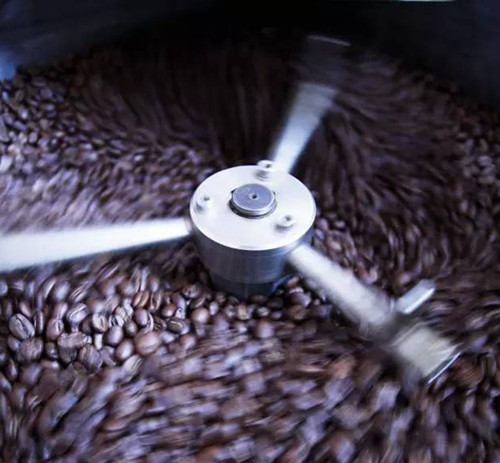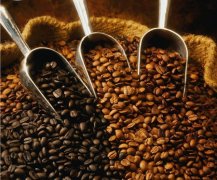The process of roasting coffee, the process of roasting coffee, the detailed explanation of coffee roasting process.
Most people think that baking is nothing, just frying the raw beans with fire. In fact, in the process of coffee processing, roasting is the most difficult step, it is a kind of science, but also an art, so in Europe and the United States, experienced roasters enjoy a highly respected status. Baking can be divided into the following three stages:

1. Drying
In the early stage of baking, the raw beans begin to absorb heat, and the water inside gradually evaporates. At this time, the color gradually changed from green to yellow or light brown, and the silver film began to fall off, you can smell a faint smell of grass. The main function of this stage is to remove moisture, which accounts for about half of the baking time, because water is a good heat transfer conductor and helps to bake the internal material of coffee beans. Therefore, although the aim is to remove water, the baker will make good use of the temperature of the water and properly control it so that it will not evaporate too quickly; in general, it is best to control the water to reach the boiling point and turn into steam in 10 minutes. At this time, the internal material is fully cooked, and the water begins to evaporate, rushing out of the outside of the coffee beans.
2. High temperature decomposition
Baked to about 160 degrees Celsius, the water inside the beans will evaporate into gas and begin to rush out of the outside of the coffee beans. At this time, the interior of the raw bean changed from endothermic to exothermic, resulting in the first burst sound. After the bursting sound, it turns to endothermic again, and the pressure inside the coffee bean is extremely high, up to 25 atmospheric pressure. Heat and pressure begin to deconstruct the original tissue to form new compounds that create the taste and taste of coffee; at about 190 degrees Celsius, the transition between endothermic and exothermic occurs again. Of course, high temperature cracking continues to occur, coffee beans from brown to dark brown, gradually entering the stage of re-baking.
3. Cooling
Coffee must be cooled immediately after roasting, quickly stop the pyrolysis at high temperature and lock the flavor. Otherwise, if the high temperature in the beans continues to work, the aromatic substances will be burned. There are two cooling methods: one is air-cooled and the other is water-cooled. The air-cooled type requires a lot of cold air to cool the coffee beans quickly within 3-5 minutes. In the field of professional baking, large roasters are equipped with a tray with a rotatable driving arm; when the baking is completed, the beans are automatically fed into the tray, and the fan at the bottom of the tray is immediately activated to blow cold air. And the pushing arm stirs the coffee beans to cool them. Although the speed of the water-cooled type is slow, it is clean and does not pollute, and it can better retain the aroma of the coffee, so it is used by the selected coffee industry. The water-cooled method is to spray a layer of water mist on the surface of the coffee beans, allowing the temperature to drop rapidly. As the amount of spraying water is very important, it requires precise calculation and control, and will increase the weight of baked beans, which is generally used in large-scale commercial baking.
Important Notice :
前街咖啡 FrontStreet Coffee has moved to new addredd:
FrontStreet Coffee Address: 315,Donghua East Road,GuangZhou
Tel:020 38364473
- Prev

Latte without coffee know these farewell coffee "Xiaobai" latte cafe barista card
In daily life in Europe, the cafe has a unique meaning, it is not only for rest, eating, meeting friends, but also become a fixed ceremony in the life of the local people. Many people still have many misunderstandings about coffee. Maybe you are also a coffee dregs. Question 1: why doesn't the matcha latte put coffee? Can baristas make coffee or not? It's not that baristas don't know how to make coffee.
- Next

Coffee roasting stage characteristics roasting coffee stage detailed explanation of roasting coffee characteristic coffee roasting
From the point of view of the baking degree, the deeper the baking degree, the stronger the bitter taste; the lighter the baking degree, the stronger the sour taste. The choice of baking degree depends on the characteristics of the coffee bean itself. for coffee beans with strong bitterness and light sour taste, they generally choose a moderate and shallow roasting degree. 1, shallow baking (Light) the lightest fried culture, no flavor and concentration, beans are not yet ripe, there are raw beans
Related
- What is the meaning of lactic acid fermentation with coffee bean treatment?
- How to judge the state of foam by sound?
- How does the latte pull out the unicorn pattern? Come to get for a little trick to improve the flower pull!
- Will flower pulling affect the taste of the latte?
- Do you know the history of coffee?
- The difference between honey treatment and sun washing what is raisin honey treatment?
- What kind of milk can a novice use to make coffee foam to keep the foam longer? The correct method and skills of milking tutorial sharing
- Why do washed coffee beans taste sour? Flavor characteristics of washed Coffee
- Introduction to the skill of how to practice the size and height of water injection around the circle of hand-brewed coffee
- How do beginners practice coffee flower drawing from scratch?

